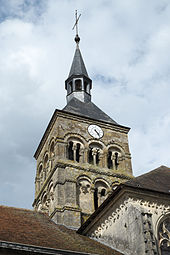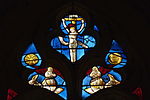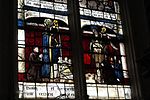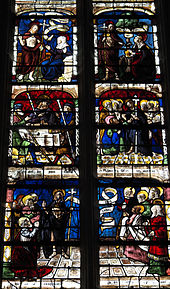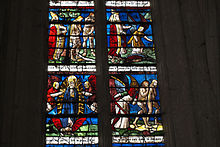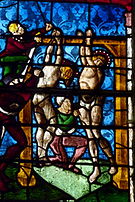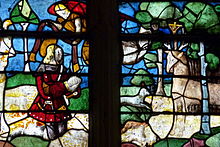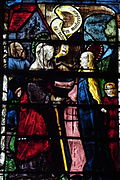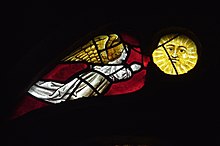St-Remi (Ceffonds)
The Catholic parish church of Saint-Remi in Ceffonds , a commune in the Haute-Marne in the French region of Grand Est , was in the middle of the 12th century in the style of Romanesque begun and in the 16th century in the style of Gothic and early Renaissance completed . Numerous leaded glass windows from the early 16th century have been preserved in the church. In 1862 the church consecrated to Saint Remigius of Reims was added to the list of architectural monuments in France as Monument historique .
history
The bell tower, the crossing and a nave of the transept date from the middle of the 12th century. The choir was built at the beginning of the 16th century in the Flamboyant Gothic style , and in 1511 the leaded glass windows were inserted . The second transept was built in 1513, and the windows were glazed in the same year. The main and side aisles followed between 1524 and 1562. In 1562 the western facade and the western side chapels were completed in the Renaissance style. As the dates 1635, 1669 and 1741 on the keystones show, the vaults were renewed in the 17th and 18th centuries. After the partial collapse of the bell tower in 1812, it was restored, as were the leaded glass windows.
architecture
Exterior construction
The square bell tower rises above the crossing . Its two floors are broken through on all four sides by three round-arched openings. These are supported by central columns on the upper floor and by half columns on the side. On the lower floor the side arcades are closed, the blind arches rest on consoles carved with human or animal heads. The capitals of the columns are decorated with geometric motifs. The two floors are rolls friese divided, which also has the archivolts run the arcade arches. The tower is crowned by a slate-roofed pyramid with an octagonal top.
The west facade is supported by far protruding, stepped buttresses. It is pierced in the middle by a round window and on both sides by a pointed arch window.
The west and south portals are designed in the Renaissance style. The south portal is framed by fluted pilasters and crowned by a triangular gable. The round arched west portal is marked with the year 1562. It is embedded between the two central buttresses and surrounded by figure niches. It is covered by a segmented gable and is also framed by pilasters.
inner space
The three-aisled nave is divided into four bays . A two-nave transept adjoins the nave. The choir opens into an apse with a five-eighth end . Chapels have been built on both sides of the western nave yoke.
Renaissance window
- Window 0: Descent from the Cross and Entombment
The central choir window shows Christ on the cross in tracery . The panes of the two lancets are dedicated to the Descent from the Cross , the Entombment and the Descent into Hell . The donors are represented on the lower panes, on the left with St. Nicholas , who can be recognized by the three scholars in the curing barrel, and on the right also with a bishop.
- Window 1: Scenes of the Passion
On the right window of the choir the scenes of Jesus 'passion are depicted: Entry into Jerusalem, Last Supper , Jesus and the sleeping disciples on the Mount of Olives, betrayal of Judas and Peter , who cut off Malchus' ear with the sword, scourging and crowning of thorns, Jesus before Pontius Pilate and Jesus carry the cross. The lower panes represent the family of the founders, on the left the wife of the founder with her daughters in the care of a martyr and on the right the founder and his sons in the care of an apostle.
- Window 2: Apparitions of Jesus
The resurrection of Christ is depicted on the two upper discs . The other scenes depict the risen Lord appearing to his mother Mary, Mary Magdalene ( Noli me tangere ), the Emmaus disciples and the apostles. The unbelieving Thomas overcomes his doubts only after he puts his finger in the wound of Jesus. The lower panes present the founder with St. Nicholas and his wife with St. Barbara .
- Window 3: Scenes from the life of St. Remigius
The window is dedicated to the patron saint of the church. One scene recalls the baptism of Clovis I , King of the Franks , who was baptized by Bishop Remigius in Reims Cathedral around the year 500 after his conversion to the Catholic faith . The donors are shown on the two lower discs.
- Window 4: Adam and Eve
The individual scenes depict the creation of Adam and Eve , the fall of man and the expulsion from paradise . After Adam and Eve eat from the tree of knowledge , they realize that they are naked. God curses the serpent, in another scene Mary steps down , surrounded by a halo, which is held by two angels, the serpent, which is shown here as a winged dragon.
- Window 5: Martyrdom of the brothers Crispinus and Crispinianus
The window depicts the martyrdom of the brothers Crispinus and Crispinianus . They are placed in a cauldron with boiling oil, from which they rise unharmed. They are chained to pillars and scourged. They are hung on ropes and their skin is peeled off. With millstones around their necks, they are pushed into the water, from which they can also escape. Eventually they are beheaded and their bodies are buried in a chapel.
- Window 6: Root Jesse
- Window 7: Saint Hubert and Saint Sebastian
The window depicts scenes from the legend of St. Hubertus and the martyrdom of St. Sebastian , on the lower panes donors accompanied by saints and bishops.
- Window 8: Scenes from the life of Mary
The window is dedicated to the life of Mary . In the lower row, two donors with their patron saints are shown on the left. The next three panes depict the meeting of Anna and Joachim at the Golden Gate, followed by the birth of Mary and her marriage to Joseph . The scenes above represent the Annunciation , the Visitation and the Nativity, which an angel announces to the shepherds on the outer right pane. The upper scenes depict the adoration of the Magi , the presentation of Jesus in the temple, the death of Mary and her ascension to heaven , and her coronation in the tracery .
- Window 9: Scenes from the life of John the Baptist
- Window 11: Stoning of St. Stephen
- Window 12: Annunciation and Saint Nicholas
- Window 14: Saints Catherine, Saints Margaret and Saints Barbara
On the window the three saints and martyrs, who are also counted among the fourteen helpers in need , are depicted with their attributes : St. Catherine with sword and wheel, St. Margaret with a dragon and St. Barbara with a tower. In the tracery you can see two angels and the personified representations of the sun and moon.
- Fragments
Only fragments are left of some windows.
Wall painting
A wall painting from the 16th century depicting St. Christopher has been preserved in the church.
Furnishing
- The church has an entombment group with life-size stone figures from the 16th century.
- The baptismal font also dates from the 16th century. Grotesque figures are carved on the polygonal base. A dew band runs over it and a frieze made of keel arches with inscribed tracery runs under the upper edge.
literature
- Henri Ronot: Champagne Novels . Éditions Zodiaque, La Pierre-qui-Vire 1981, p. 357.
Web links
- Église Saint-Remi in the Base Mérimée of the French Ministry of Culture (French)
- Eglise Saint-Remi de Ceffonds structurae (accessed October 14, 2015, French)
- Église paroissiale Saint-Rémi Direction Régionale des Affaires Culturelles de Champagne-Ardenne (accessed on October 14, 2015, in French)
Individual evidence
- ↑ Entombment in the Base Palissy of the French Ministry of Culture (French)
- ↑ Baptismal font in the Base Palissy of the French Ministry of Culture (French)
Coordinates: 48 ° 28 ′ 16.7 " N , 4 ° 45 ′ 50.1" E

